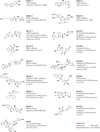Advancing Biological Understanding and Therapeutics Discovery with Small-Molecule Probes
- PMID: 26046436
- PMCID: PMC4564295
- DOI: 10.1016/j.cell.2015.05.023
Advancing Biological Understanding and Therapeutics Discovery with Small-Molecule Probes
Abstract
Small-molecule probes can illuminate biological processes and aid in the assessment of emerging therapeutic targets by perturbing biological systems in a manner distinct from other experimental approaches. Despite the tremendous promise of chemical tools for investigating biology and disease, small-molecule probes were unavailable for most targets and pathways as recently as a decade ago. In 2005, the NIH launched the decade-long Molecular Libraries Program with the intent of innovating in and broadening access to small-molecule science. This Perspective describes how novel small-molecule probes identified through the program are enabling the exploration of biological pathways and therapeutic hypotheses not otherwise testable. These experiences illustrate how small-molecule probes can help bridge the chasm between biological research and the development of medicines but also highlight the need to innovate the science of therapeutic discovery.
Copyright © 2015 Elsevier Inc. All rights reserved.
Figures



References
-
- Adibekian A, Martin BR, Chang JW, Hsu KL, Tsuboi K, Bachovchin DA, Speers AE, Brown SJ, Spicer T, Fernandez-Vega V, Ferguson J, Hodder PS, Rosen H, Cravatt BF. Confirming target engagement for reversible inhibitors in vivo by kinetically tuned activity-based probes. J Am Chem Soc. 2012;134:10345–10348. - PMC - PubMed
-
- Anastasiou D, Yu Y, Israelsen WJ, Jiang JK, Boxer MB, Hong BS, Tempel W, Dimov S, Shen M, Jha A, Yang H, Mattaini KR, Metallo CM, Fiske BP, Courtney KD, Malstrom S, Khan TM, Kung C, Skoumbourdis AP, Veith H, Southall N, Walsh MJ, Brimacombe KR, Leister W, Lunt SY, Johnson ZR, Yen KE, Kunii K, Davidson SM, Christofk HR, Austin CP, Inglese J, Harris MH, Asara JM, Stephanopoulos G, Salituro FG, Jin S, Dang L, Auld DS, Park HW, Cantley LC, Thomas CJ, Vander Heiden MG. Pyruvate kinase M2 activators promote tetramer formation and suppress tumorigenesis. Nat Chem Biol. 2012;8:839–847. - PMC - PubMed
-
- Arrowsmith J. Trial watch: Phase II failures: 2008–2010. Nat Rev Drug Discov. 2011a;10:328–329. - PubMed
-
- Arrowsmith J. Trial watch: phase III and submission failures, 2007–2010. Nat Rev Drug Discov. 2011b;10:87. - PubMed
-
- Aubert RE, Herrera V, Chen W, Haffner SM, Pendergrass M. Rosiglitazone and pioglitazone increase fracture risk in women and men with type 2 diabetes. Diabetes Obes Metab. 2010;12:716–721. - PubMed
Publication types
MeSH terms
Substances
Grants and funding
- U54 HG005033/HG/NHGRI NIH HHS/United States
- U54 MH084691/MH/NIMH NIH HHS/United States
- U54 MH084512/MH/NIMH NIH HHS/United States
- U54 MH084659-01/MH/NIMH NIH HHS/United States
- U54 MH084659/MH/NIMH NIH HHS/United States
- 1 U54 HG005034-01/HG/NHGRI NIH HHS/United States
- 1 U54 HG005031-01/HG/NHGRI NIH HHS/United States
- U54 HG005032/HG/NHGRI NIH HHS/United States
- U54 MH084690-01/MH/NIMH NIH HHS/United States
- U54 MH084690/MH/NIMH NIH HHS/United States
- 1 U54 HG005032-01/HG/NHGRI NIH HHS/United States
- U54 MH084681-01/MH/NIMH NIH HHS/United States
- U54 MH084691-01/MH/NIMH NIH HHS/United States
- U54 HG005031/HG/NHGRI NIH HHS/United States
- R13 NS084681/NS/NINDS NIH HHS/United States
- U54 MH084512-01/MH/NIMH NIH HHS/United States
- U54 HG005034/HG/NHGRI NIH HHS/United States
- 1 U54 HG005033-01/HG/NHGRI NIH HHS/United States
LinkOut - more resources
Full Text Sources
Other Literature Sources

